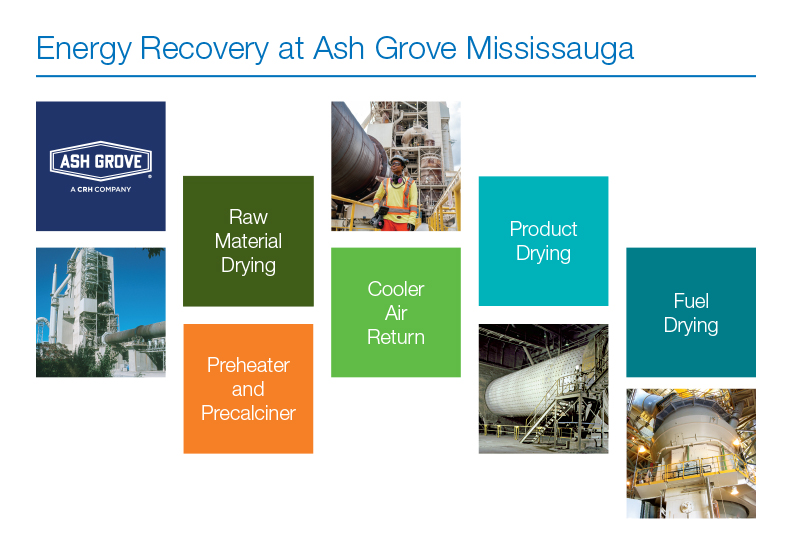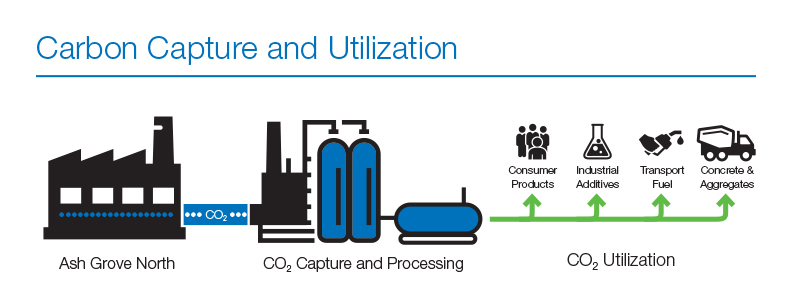Environment & Sustainability
Climate Change Mitigation
Ash Grove North’s Mississauga Cement Plant is Committed to Climate Change Mitigation
Ash Grove North’s Mississauga cement plant is committed to climate change mitigation through a comprehensive Climate Change Strategy aimed at reducing greenhouse gas emissions (GHG) from the plant. Canada is a world leader in the fight against climate change taking action to reduce carbon through carbon pricing, improving energy efficiency, driving innovation and investing in strategic transportation options.
Climate Change Mitigation
In Canada there is support in taking action on Climate Change by ensuring businesses reduce emissions while continuing to provide economic benefits to our communities.
With 5% of the worlds CO2 emissions resulting from cement manufacturing, the cement industry is actively involved in finding solutions to this challenge, not only as an emitter of greenhouse gasses (GHG) but also as a key provider of infrastructure solutions to manage adaptations related to climate change impacts.
The Ash Grove North Mississauga cement plant Climate Change Mitigation Strategy focuses on five key areas to reduce greenhouse gas emissions from our operations, namely:
Energy Efficiency
Clinker Substitution
Low-Carbon Fuels
Natural Resource Conservation
Carbon Capture and Utilization
These initiatives are not without their challenges in the form of policy modernization, customer adoption, technological innovation, community engagement and financial investment. However, Ash Grove North is committed to be a leader in the low-carbon economy and engages with its customers, community, regulators, researchers, and business partners to drive change. We look to these stakeholders as advisors in our processes to create lasting change within our operations and beyond. Learn more about the Community Advisory Panel, the External Advisory Committee, and the critical role our community stakeholders play in driving positive change by clicking here.
External Advisory Panel
Under our Climate Change Strategy, we expect to evaluate a number of project ideas aimed at reducing GHGs and improving energy efficiency in the future at the Ash Grove North Mississauga cement plant. Leveraging our community engagement efforts, we have formed an External Advisory Panel (EAP) to assess proposed projects from a sustainability perspective, including climate change impact, local environmental impacts, public health and community relations.
The Panel will provide an Ash Grove North project team with recommendations on the merits of the projects under consideration, as well as reporting to our Community Advisory Panel (CAP) on the progress being made in the identification and implementation of greenhouse gas reducing projects. The four-member EAP panel consists of external experts with knowledge of the cement industry, low carbon fuels, environmental science, innovation (climate change), health science and stakeholder relations.
For more information related to our External Advisory Panel (EAP) click here.
Energy Efficiency
Cement manufacturing, by its nature, requires significant thermal and electric energy. Intense thermal heat requirements exceeding 1450 degrees Celsius are required for the chemical reaction to transform the raw materials. The temperature of the chemical reaction cannot be adjusted, but the recycling and reuse of this heat can – and this is where Ash Grove North has focused its efforts for many years.
Starting in 1968, Ash Grove North made major investments to upgrade its operations at the Mississauga cement plant to state-of-the-art kiln technology – from wet-kiln technology to dry-kiln technology with a preheater and precalciner. This major technological upgrade reduced the thermal requirement of the process by nearly 50%. This was possible due to using dry rather than wet raw material inputs (which required improved control systems), the use of convective heating to “preheat” incoming raw material before it entered the kiln, and a secondary thermal energy input known as a precalciner to balance the thermal energy distribution to reduce convective losses along the system. In addition, the heat that is generated from the cooling of clinker as it exits the kiln is recycled back into the kiln to further reduce the needed thermal input.
We continued our focus on thermal energy efficiency by redistributing heat that would otherwise be released through our main (large) stack. The heat is distributed to dry raw materials and fuels before they enter the kiln.

Electrical energy is consumed primarily in the grinding (size reduction) of the finished product before it is shipped to customers. In 1974, Ash Grove North invested in a new cement mill that operates at a larger capacity with more efficient separation, significantly reducing the electrical energy requirements. The Vertical Roller Mill, used for slag grinding, installed in 2007 also reduced the electrical energy demand. Further electrical efficiency improvement projects are being considered.
Clinker Substitution
Clinker is the primary ingredient of cement. Traditional Portland Cement consists of more than 90% clinker – the product that results from the chemical transformation that occurs in the kiln. Modern Portland Cement consists of a number of additional materials that add specific qualities to the cement based on the application. These can include limestone, fly ash, slag or other natural pozzolans.
An example of clinker substitution is Portland-Limestone cement (PLC). PLC is manufactured by intergrinding Portland cement clinker with 6% – 15% limestone. With up to an additional 10% of the clinker replaced with limestone when comparing to Traditional Portland cement, PLC manufacturing reduces CO2 emissions by up to 10% from the manufacturing process. At Ash Grove North’s Mississauga Cement Plant we currently manufacture this low carbon cement called GUL as part of our sustainable suite of products.
Slag cement is another example of substituting not only clinker – but cement completely. Ash Grove North’s Slag Cement substitutes post-industrial materials in place of raw virgin materials and is produced with no further GHG emissions than when utilizing kiln gases from the cement kiln to dry the material during the grinding process. Slag cement creates a concrete with higher overall strength and durability resulting in decreased life cycle costs. The end result is a product with an overall lower carbon footprint.
Clinker substitution is the most direct way to reduce the greenhouse gas impact associated with cement manufacturing as it bypasses the thermal process completely. It is our goal to maximize clinker substitution by having our customers adopt these products whenever possible. In fact, these products have become the sustainable choice for many large-scale projects as it helps builders in obtaining LEED® Certification.
Low Carbon Fuels
Fuel use in the manufacturing of clinker (the intermediary product of cement) represents approximately 40% of the GHG emissions from cement manufacturing. In order to produce the high temperature required to transform raw materials such as limestone and shale into clinker – significant quantities of fuels are utilized at our facility.
Over the years, we have taken steps to move to lower carbon fuels as well as making efforts to move away from mined, virgin fossil fuels. We have significantly reduced our use of coal by introducing petroleum coke – a by-product of the oil industry that has a lower GHG impact per unit of energy. Additionally, our facility has been designed specifically to offset significant amounts of energy from coal by utilizing the energy content of oils and solvents. The Mississauga cement plant has incorporated oils and solvents into our process since the 1970’s. These fuels must meet Ash Grove North specifications, with every load additionally verified before being received. The use of these fuels not only diverts wasted resources and reduces coal use, but also, as with petroleum coke, produces lower GHG impact per unit of energy.
Governments and industry groups around the world have identified the use of lower-carbon fuels as key lever to reduce GHG emissions from cement manufacturing. The Government of Ontario is among them – recognizing the opportunity for energy-intense industries to use recovered fuels to reduce GHG emissions, playing an important role in the circular economy by reusing by-products from other industries otherwise destined for landfill or incineration and reducing the need for virgin fossil fuels.
As we move forward towards a green Canadian economy, we look to continue leading our industry in reducing GHG emissions from fossil fuel use. We are working closely with our stakeholders including our External Advisory Panel to identify sustainable sources of low-carbon alternative fuels in order to reduce our reliance on GHG intensive fossil fuels such as coal.
Natural Resource Conservation
Concrete, which includes cement as the binder, is the second most used material in the world. Natural resource conservation is a major consideration of the material industry and Ash Grove North is no exception.
As a manufacturer of these materials, we see not only the challenge but the opportunity to shift our thinking from a linear production line to a circular one. With concepts such as construction shale as raw material feed, petcoke utilization, recovery of waste oils/solvents, and Ash Grove North Slag Cement – the Ash Grove North Mississauga cement plant has reduced its reliance on natural resources by approximately one third for both fuel and raw material. Combined, that’s over 500,000 tonnes of material that came from by-products of other industries to make the cement that leaves our facility.
We are constantly looking for materials that can be reused in our processes to minimize the amount of raw material or fuel that requires mining. Our aim is to reduce society’s reliance on non-renewable resource extraction as well as avoid useful resources ending up in landfills – and as we move to a circular economy that will only grow!
We encourage you to read more about Ash Grove North and the Circular Economy here.
Carbon Capture & Utilization
Carbon capture is an evolving technology that enables CO2 gases to be separated and captured from the raw flue gas. After capture, it can either be stored in deep underground geological formations, or it can be utilized as an input feedstock for new products. As you can see below in the Original and Concrete/RCA (Recycled Concrete Aggregate) schematic, Ash Grove North’s focus for reducing carbon emissions will be to utilize the CO2 in products that promote the circular economy.
We are actively monitoring and supporting research and demonstration projects in this area as we see the need for these technologies in the future as we transition to the low carbon economy. As with our own efforts to reuse the by-products of other industries, we are focusing on ways that our by-product (CO2) can be used as a useful input to other industries.
